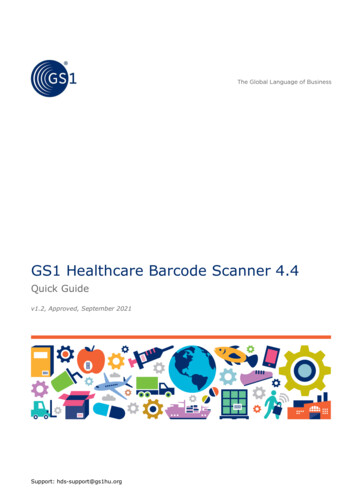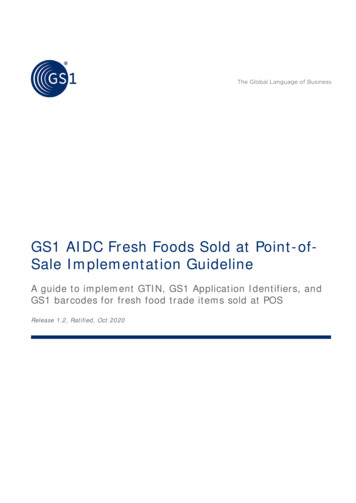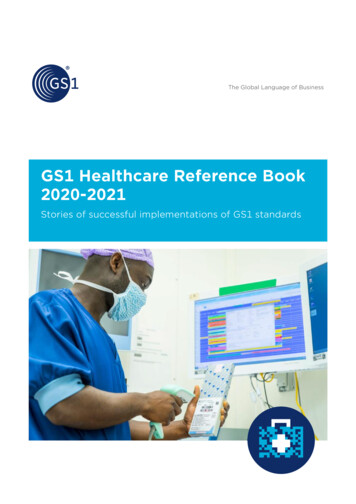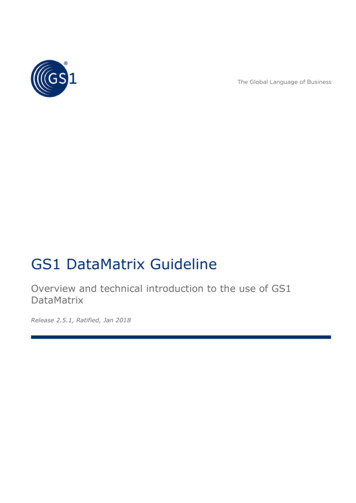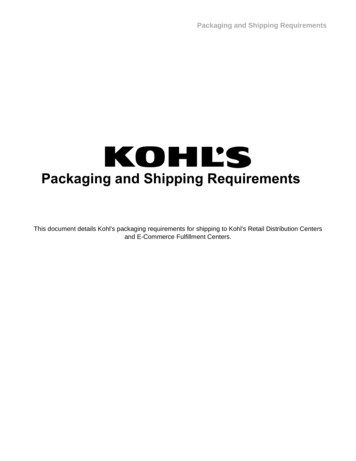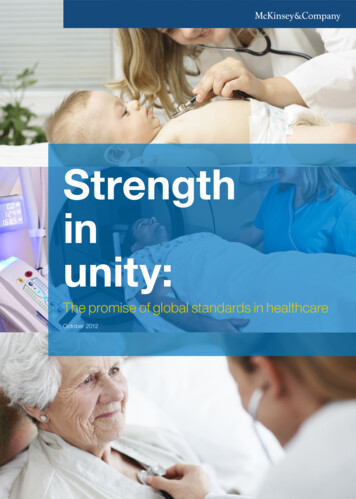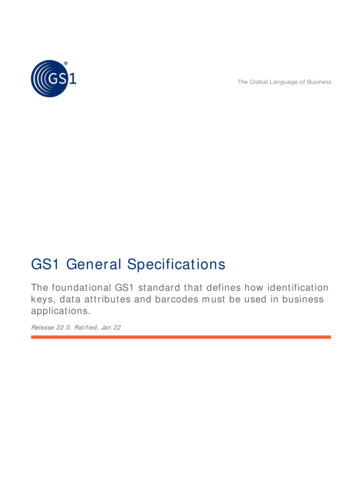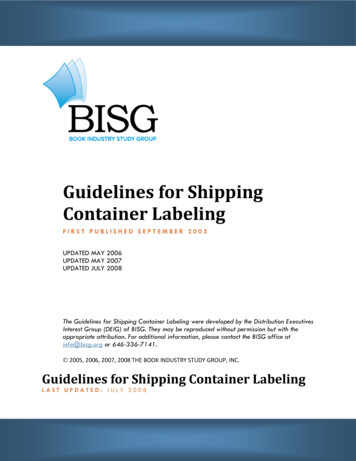
Transcription
The Global Language of BusinessGS1 Healthcare Reference Book2021-2022Stories of successful implementations of GS1 standards
GS1 Healthcare Reference Book 2021-2022THIS DOCUMENT IS PROVIDED “AS IS”WITH NO WARRANTIES WHATSOEVER,INCLUDING ANY WARRANTY OFMERCHANTABILITY, NONINFRINGMENT,FITNESS FOR PARTICULAR PURPOSE, OR‘‘‘‘Safer, moreefficient carestarts with asimple scan.ANY WARRANTY OTHERWISE ARISINGOUT OF THIS DOCUMENT.GS1 disclaims all liability for any damagesarising from use or misuse of thisReference Book, whether special, indirect,consequential, or compensatory damages,and including liability for infringement ofany intellectual property rights, relating touse of information in or reliance upon thisdocument. GS1 retains the right to makechanges to this document at any time,without notice. GS1 makes no warrantyfor the use of this document and assumesno responsibility for any errors which mayappear in the document, nor does it makea commitment to update the informationcontained herein.GS1 and the GS1 logo are registeredtrademarks of GS1 AISBL.23
GS1 Healthcare would like to express its gratitude to thefollowing organisations and experts who contributed to thisedition of the GS1 Healthcare Reference Book: 1WorldSync - Abbott Laboratories, Geisinger Health, Johnson & Johnson Supply Chain,Teleflex Incorporated, US ANDI, FENALCO and GS1 Colombia - Orietta Paola Morales Barros, César Javier Becerra,Leonel Pava Casilimas, Paola Alexandra Morales León, Ivan Gustavo Montaño Morales,Colombia Australian Capital Territory Health - Katrina Keep, Peter Niven, Peter O’Halloran,Australia Bulgarian Medicines Verification Organisation - Desislava Dimitrova, Bulgaria Fresenius Kabi - Matt Farley, Angie Lindsey, Jeanne Sirovatka, Gwen Volpe, US Health Service Executive – Dr. Lucy Jessop, Cliona Kiersey, Kerry Ryder, Ireland Hull University Teaching Hospital - Rachael Ellis, UK Johnson & Johnson Supply Chain - Vivek Nadadur, Leandro Oliveira, Lindsay Tao, China Ministry of Health, Labour and Welfare - Masayuki Muraoka, Japan Netcare - Caroline Potgieter, South Africa North Denmark Region - Camilla Schnell Steen, Denmark North Tees and Hartlepool NHS Foundation Trust - Anthony Kennerley, Tony Naylor, UK Réseau des Acheteurs Hospitaliers - Stéphane Ancel, Jean-Michel Descoutures, CamilleLabeaune, France St. James’s Hospital - Vincent Callan, John Gibbons, Ireland Serum Institute of India - Dr. Sunil Gairola, India Sanofi - Pierre Fernandez-Barbereau, France University Clinical Centre of the Medical University of Warsaw - Maciej Zabelski, PolandWe would also like to thank the GS1 Member Organisations(MOs) who helped facilitate the creation of this book: GS1 Australia - Catherine Koetz GS1 Bulgaria - Desislava Dimitrova GS1 Colombia - Orietta Paola Morales Barros, César Javier Becerra, Leonel PavaCasilimas, Paola Alexandra Morales León, Ivan Gustavo Montaño Morales GS1 Denmark - Jesper Kervin Franke GS1 France - Laurence Azoulay, Aurélie Escobar GS1 India - Sachidanantham Swaminathan GS1 Ireland - Amanda Creane, Siobhain Duggan, Denis O’Brien GS1 Japan - Koichi Uemura GS1 Poland - Anna Gawrońska GS1 South Africa - Nuran Idris, Martin Kairu, Michele Francis Padayachee GS1 UK - Glen Hodgson, Natasha Smith GS1 US - Peter SturtevantNeed to contact an MO? Visit the GS1 website: www.gs1.org/contact.5
GS1 Healthcare Reference Book 2021-2022What’s insideGS1 standards arehealthcare aroundenabling the transformation ofthe worldPandemic storiesp.12ACT Health uses GS1 standards to createinnovative solutions to fight COVIDand build trust with their population Australiap.16Serum Institute of India: ImplementingUNICEF guidelines for distribution ofCOVID vaccines - Indiap.20Traceability standards enabling a safer,more efficient rollout of the COVID-19vaccine - Irelandp.30GS1 Digital Link helps deliver valuablee-leaflet information to healthcareproviders and patients - JapanHealthcare providersp.36Improving patient safety with simplescans - Denmarkp.40Implementing RFID-enabled technologyfor the transport of precious laboratorysamples at St. James’s Hospital - Irelandp.46Enhancing patient safety byimplementing an electronic systemfor medical orders and GS1 barcodescanning - Polandp.52Netcare: Investing in GS1 standards andquality product information for patientsafety - South Africap.56CareScan : Enabling safer, more efficientpatient care while reducing costs - UKp.62Connected, continuous and complete:Implementing Scan4Safety using GS1standards at the core of the patientpathway - UKUSIrelandUKFranceDenmarkPoland 1WorldSync & GDSNincrease supplychain efficienciesand enhance patientsafety with accurate,enriched data. St. James’s Hospitalhas full visibilityof the movementof laboratoryspecimens. Recalls that couldonce take weeksnow take only hours,saving significanttime for medical staffat Hull UniversityTeaching Hospital. 50% reduction in timespent by Sanofi onlabelling clinical trialkits for increasedproductivity.North DenmarkRegion’s CardiacLaboratory saves 134,000 each yearby scanning GS1barcodes.70% improvement inuse of doctors’ timeat The UniversityClinical Centre of theMedical University ofWarsaw.BulgariaJapanBulgarian MedicinesVerification Systemvirtually eliminatescounterfeit drugs frombeing dispensed.Latest, up-to-datepharmaceuticaland medical deviceinformation is nowavailable to healthcareproviders via e-leafletson the Pharmaceuticalsand Medical DevicesAgency. Fresenius Kabi giveshospitals the abilityto achieve moreprecise inventorymanagement, byreading many RFIDtags with one scan.many RFID tags inone scan. Ireland’s publichealth authority,HSE, achievedvisibility of COVID-19vaccine usage andtraceability to thepoint of vaccinationacross all of itsvaccination centres. CareScan at NorthTees and HartlepoolNHS FoundationTrust provides patientsafety alert in aninstant. Cost reductionsrelated to dataerrors, minimising oreliminating disputes,re-entries and morewith Resah’s eCatSanté.ChinaSuppliers & GPOp.68Johnson & Johnson Supply Chain: Theevolution of pharmaceutical producttraceability - Chinap.72Sanofi uses GS1 standards in clinicaltrials for significant operational andhuman health benefits - Francep.76Digitise healthcare product informationto improve procurement and supplychain management - Francep.82Fresenius Kabi: First to providehealthcare providers with GS1 EPCenabled RFID tagging at the dosagelevel - USp.901WorldSync: Leveraging the GDSN toimprove the healthcare supply chain - USGovernment initiatives6p.98Successful implementation of theBulgarian Medicines Verification System Bulgariap.102UDI pilot with the Ministry of Health andSocial Protection - ColombiaJohnson & JohnsonSupply Chain deploysa cost optimised andlocalised solutionbenefiting healthcareproviders and patients.AustraliaACT Health quickly putin place new COVIDrelated processes,systems and contacttracing app based onGS1 standards.ColombiaUDI enablestraceability andimproved managementpractices related tospending in Colombia’sGeneral System ofHealthcare SocialSecurity.IndiaSouth AfricaTraceability enabledby GS1 standardshelps Serum Instituteof India bettermanage inventoryand distribution ofits COVID vaccineexports.85% of products usedby Netcare have GS1barcodes applied bysuppliers.7
GS1 Healthcare Reference Book 2021-20222021: A year of hope and the new normalLast year at this time, we were all battling thefirst waves of the COVID-19 virus and the globalhealthcare industry was racing to find a vaccine.This year, while the world continues to grapplewith this dangerous pandemic, 2021 has becomea year of “hope” with the introduction of notone—but multiple vaccines—that we all hope willrestore life to some semblance of normal.At the same time, many argue that life isreturning to a “new normal”—filled with changesin the ways we work, play and interact. Clearly,the healthcare sector has been especiallychallenged in this time, often pushed to itslimits. Yet, it has also been transformed throughinnovation and adaptation. The way thatall parts of the healthcare community haveworked together to make change happen isinspirational—a collaboration that will ultimatelybenefit every patient.What does this mean for GS1 standards, andhow will we apply our learnings for a brighterfuture?While the pandemic has challenged the digitalfoundation of our global healthcare supply chainand national care systems, investments in GS1standards by healthcare suppliers and providershave strengthened these foundations. And,the further use of GS1 standards will make thefoundations even more resilient when providing asecure and efficient supply chain.GS1 standards are enabling healthcaresystems to put in place processesand practices for COVID-19 testing,contact tracing, and vaccineidentification and administration.When Ireland’s Health Service Executive (HSE),the country’s health authority, needed tovaccinate its population of five million people,the HSE turned to GS1 Ireland as the traceabilitystandard experts. The team collaboratedto create a standardised label for vaccinepackages, a scanning app for vaccine receiptand a full traceability system in the CentralVaccination Centres (CVCs) to identity, label,track and report on vaccines and give nationalvisibility for informed, rapid decisions for thesafe and efficient vaccination of the population.In Japan, an amendment to the Pharmaceuticalsand Medical Devices Act called forpharmaceutical and medical device marketingauthorisation holders to transition from paperbased to electronic leaflets for their products.To date, nearly all pharmaceutical manufacturersand some of medical device manufacturershave completed the registration process so8that healthcare providers can simply scan aproduct’s barcode and GS1 Digital Link directsthem to the product’s e-leaflet on the Ministry’swebsite. This includes COVID vaccines.Serum Institute of India adopted globalstandards to create a traceability system tofulfil the UNICEF mandate for supplying COVIDvaccines to other countries. Now, the vaccinemanufacturer has increased visibility of itsvaccines in the supply chain in real-time toefficiently manage inventory and distribution.When ACT Health from Australia wasfaced with the COVID-19 virus, thehealth system lost no time making useof GS1 standards when developing acontact tracing app, identifying morethan 27,000 sites with Global LocationNumbers (GLNs). And, in only 15 days,the team developed the system andprocess for scanning vaccine barcodesto administer vaccinations, linkingthem to the electronic health recordsof patients.Hospitals continue to drive towardgreater efficiencies by automatingprocesses.In the North Denmark Region, hospitals are usingGS1 standards to save 12 minutes on each surgerybased on an automated replenishment processwhere staff scan barcodes on the products used intheir surgical departments.In Poland, The Paediatric Teaching ClinicalHospital automated its clinical and businessprocesses, supported by GS1 standards. Now,medical orders can be automatically generatedand, as medications are administered to patients,GS1 barcodes are scanned to ensure the rightpatient gets the right medicine, at the righttime, recording this information in the patient’selectronic medical record.St. James’s Hospital in Dublinuses GS1 standards-based RFIDtechnology to track the movementof laboratory samples throughoutthe hospital, a solution that is partof the hospital’s broader traceabilitystrategy called PATH (Patient andAsset Tracking in Healthcare).Major benefits of using GS1 standardsrevolve around the patient’s journey,safety and care.The Netcare Group in South Africa is scanningGS1 barcodes on pharmaceutical drugs andmedical devices as they are received in thehospital’s pharmacy and theatre storage rooms,and as they are used throughout wards andoperating theatres. With automated processes,Netcare nurses and staff can now focus moreon patient care.Hull University Teaching Hospital (HUTH)in the UK replaced its manual and paperbased processes with automated ones byimplementing GS1 standards throughout theentire patient care journey. Transparent andreal-time data collected at points of care hashelped HUTH deliver better patient outcomesand identify the actual cost of care per patient.North Tees and Hartlepool NHS FoundationTrust in the UK developed its own point-of-caretool called CareScan that uses GS1 standardsto track and trace any product and asset usedby staff during the delivery of care to patients.Patient safety alerts and decision supportmechanisms are built in for clinicians.Suppliers are standardising processesto better serve healthcare providersand patients.Leveraging the Global Data SynchronisationNetwork (GDSN ), 1WorldSync has developeda unique solution—the 1WorldSync Playlist—to improve efficiencies and enable scalabilityin healthcare supply chain data exchange. Apilot program was undertaken with a majorhealthcare provider and medical productmanufacturers.Fresenius Kabi, a global healthcare company,launched an ambitious program to tag vialsof medication using Electronic Product Codeenabled radio frequency identification (EPC/RFID) technology.As a public purchasing organisation in France,Resah offers manufacturers and hospitals aninteroperable electronic catalogue: eCat-Santé.The catalogue enables the input and outputof comprehensive, standardised and up-todate product information, reducing their timeand costs associated with product informationmanagement.Sanofi, a global biopharmaceutical company,worked with its supply chain stakeholders totransition from the use of seven proprietarybarcodes to one standardised GS1 DataMatrixbarcode. This standardised approach helpsSanofi’s clinical trial supply chain manageclinical trial activities so that the rightinvestigational kit goes to the right patient.Johnson & Johnson Supply Chain(JJSC) converted from nationalChinese medicines identificationand barcoding requirements tothe use of a globally standardisedapproach, using GS1 standards. Thishas provided JJSC an opportunityto increase overall operationalefficiency and product traceability.Government initiatives are makingsignificant strides in using GS1standards for patient safety.In Bulgaria, a massive project has beenundertaken to implement GS1 standards for theidentification of every pharmaceutical package,in compliance with the EU’s Falsified MedicinesDirective. The Bulgarian Medicines VerificationSystem (BgMVS) was created so that whenpharmacies dispense medicines, the medicinepack can be certified as “authentic,” enabled bythe GS1 Global Trade Item Number (GTIN ).Representatives from GS1 Colombia, theNational Association of Businessmen ofColombia (ANDI) and National Federation ofMerchants (FENALCO) have been workingwith Colombia’s Ministry of Health and SocialProtection to identify why and how it wouldimplement Unique Device Identification for allmedical devices.Turning the corner into 2022Looking ahead, we have much to be gratefuland hopeful about . . . and much to do aswe continue to digitally transform our globalhealthcare supply chain, hospital and other careenvironments.At GS1 Healthcare, we will work together,continue to implement global standards, sharebest practices and collaborate to further improvehealthcare around the world.We’re on the road to renewal and recovery,and whilst we know there will be twists andturns, GS1 standards are playing an activerole in helping the healthcare sector adapt tothe challenges that lie ahead and accelerateimprovements and innovation further—forpatient safety worldwide.9
GS1 Healthcare Reference Book 2021-2022PandemicstoriesLearn how health agencies, manufacturers andhospitals are addressing the challenges of thepandemic with GS1 standards.1011
GS1 Healthcare Reference Book 2021-2022ACT Health uses GS1 standards to create innovative solutions to fight COVID and build trust with their populationAustraliaACT Health uses GS1 standards to createinnovative solutions to fight COVID and build trustwith their populationChallengeWhen the COVID-19 virus hit Australia, theAustralian Capital Territory’s health system (ACTHealth) faced the challenge of containment,testing and administering vaccinations.6 hourturn around for COVIDtesting results27,000 sitesidentified by Global LocationNumbers where visitors can“check in” using the contacttracing appSolutionThe ACT Health team acted quickly to leverageexisting tools and, at the same time, put in placenew processes, systems and a contact tracing appthat took advantage of its knowledge and existinguse of GS1 standards.ACT Health serves a population ofapproximately 440,000 people in the AustralianCapital Territory and about 200,000 in thesurrounding regional areas. Three hundredkilometres south of Sydney, ACT Health hasthree main hospitals with approximately 1,200beds. The Canberra Hospital (the largest of theACT Health hospitals) has the second busiesthospital helipad in Australia, receiving patientsfrom rural New South Wales as a major traumacentre.For more than 13 years, ACT Health has beenon the forefront of implementing and using GS1standards, integrating standards into many ofits business and clinical processes. The healthsystem has worked to assign GS1 identifiers forstaff members and patients, as well as all itslocations, from receiving points in pharmaciesto ward storage closets. It also makes useof GS1 barcodes applied by manufacturersto pharmaceuticals and medical devices byscanning them at different points of care withinits hospital environments.12Peter O’Halloran,CIO, ACT HealthBased on the health protocols, it is requiredthat people quarantine as soon as they knowthey have had possible contact with a COVIDpositive person, have been at an exposure site orif they have symptoms. That quarantine periodwill end when they receive the appropriatelytimed negative test results, as defined by healthprotocols. “With test results reduced from48 hours to now only taking overnight, thisreduced time has had real-life implications forpeople and their families,” says Mr. O’Halloran.Building trust with contact tracing15 daysto develop a vaccinationsystem where vaccinebarcodes are scannedA very good foundation“Over time, we have been able torefine our processes, leveragingstandards and the turnaround timefor test results, which dependingon demand, can be as little as6 hours.”4 contributorsto successfully care for itspopulation and patients: staff,infrastructure, innovation andGS1 standards“GS1 standards are providing a very goodfoundation for us,” says Peter O’Halloran, ChiefInformation Officer, ACT Health. “I get excitedby standards—not only for how they havehelped us in the past, but how they are alsomaking a difference for us in our COVID-19response.”Testing with quick resultsThroughout the pandemic, all the statesand territories of Australia have focused onpreventative and containment measures liketesting and contact tracing and, at the sametime, increasing vaccination rates in thepopulation in readiness for the “new normal”–living with COVID.ACT Health has followed that nationaldirection. “We’re using specimen labels,collected during tests in drive-through testingcentres and other testing sites, and leveragingGS1 standards to actually get those specimensstraight into the analyser in a machine-readableformat,” explains Mr. O’Halloran.Being able to identify the contacts of positivecases is a foundational pillar to the Australianresponse to COVID. Another GS1 standard,the Global Location Number or GLN, hassupported the health system’s contact tracingapplication. Using manual processes, such assifting through handwritten records, produceda huge challenge for ACT Health staff whentrying to trace people’s whereabouts and visitsto locations.“ACT Health came up with a simple smartphoneapp that allowed people to ‘check in’ atlocations and put our people in control,”explains Mr. O’Halloran. “People can walk up toa venue, and scan a QR code to register theirattendance. If needed due to a positive casevisiting a location, the data can be providedWhen ACT Health from Australiawas faced with the COVID-19virus, the health system lost notime making use of GS1 standardswhen developing a contacttracing app, identifying more than27,000 sites with Global LocationNumbers (GLNs).And, in only 15 days, the teamdeveloped the system andprocess for scanning vaccinebarcodes to administervaccinations, linking them tothe electronic health records ofpatients.directly to our contact tracers. In the ACT witha population of about 440,000, as of October2021, we’ve seen more than 27,000 venuesregistered and 75 million check-ins.”During recent COVID-19 outbreaks, the contacttracing app has proven to be highly useful.In fact, three other states and territories inAustralia have adopted the app for theirown contact tracing activities. The ACTteam designed and developed the app forthe three jurisdictions on a cost recoverybasis, recognising the benefit of having aninteroperable app able to be used acrossmultiple states and territories. “Half of Australiais now using the app,” explains Mr. O’Halloran.“Sharing the app means that when vaccinationtargets are met, we are helping to open up thecountry.”Since the app uses GLNs, the ACT Health teamimplemented a central registry, shared by allthe states and territories leveraging the app.When someone scans the code, the systemknows it’s a code from the “XYX” location. Thedata is sent directly to the contact tracers inthat jurisdiction.“It’s simple and easy, since we based the app onstandards,” says Mr. O’Halloran. “It’s exciting—not just the technology and standards—but theoutcomes are what’s really exciting us. Howcan this help open up the country safely? Howdoes this improve patient outcomes? How doesthis let us get on top of an outbreak quicker?”ACT Health strongly promoted the app toensure that people understood the benefits.“It’s all about engaging with the community.Building their trust has been essential for allthat we’ve done.”13
GS1 Healthcare Reference Book 2021-2022ACT Health uses GS1 standards to create innovative solutions to fight COVID and build trust with their populationAbout the authorsGetting jabs in armsIt was 27 December 2020 when Peter O’Hallorangot the call from the head of ACT’s HealthDirectorate saying that vaccines were arriving inFebruary 2021, and it was “all hands on deck” toplan for their arrival and administration to ACTHealth’s waiting population.When ACT Health received the first shipmentsof vaccines in February, the team was relievedto find the packages were labelled with GS1identifiers encoded in GS1 barcodes. “Until wereceived them, we didn’t have absolute suretythat the vaccines’ packaging would be markedwith GS1 barcodes,” says Mr. O’Halloran. “Thesupply chain in those early days was working veryhard to ramp up capabilities to bring vaccines tomany countries across the world. We had to reactquickly when we received deliveries.”“It was a relief that we could use oursystem and scanners to read thebarcodes, do all the patient safetychecks, and upload all patient andvaccine information into the EMRsystem. It was amazing.”Peter O’Halloran,CIO, ACT HealthPeter O’Halloran and his team are working toensure ACT Health’s legacy pharmacy inventorymanagement system is integrated in their vaccinemanagement process. They have also developedcapabilities to load data into the AustralianImmunisation Register (AIR), which is a nationaldatabase containing all the details about thosewho have been vaccinated. The registry willalso be used to issue “vaccine passports” toAustralians who are planning to travel.As of 26 October 2021, ACT is leading the nationwith in excess of 99% of the 12 years and olderpopulation having had a 1st vaccine dose and89.3% having had their 2nd dose. In addition, theACT has administered significant number ofvaccinations to citizens from the surroundingregion in New South Wales. The ACT hasadministered more than 800,000 doses.14Peter O’Halloran,CIO, ACT HealthContributors of successEven with all the challenges the ACT Healthteam has faced, Mr. O’Halloran is quick to pointout that GS1 standards and barcodes have beena key foundation. “Standards help us deal withall we have to do.”“What has contributed to our success? One,we have a phenomenal workforce that metthe COVID-19 challenge and continues to doso every day in what can be very challengingcircumstances.“Secondly, we have the infrastructure—not onlythe IT technology but also the infrastructure ofGS1 standards for identifying people, locationsand products. Standards have been key, helpingus to ensure that the risk of patient-safety issuesis reduced and, in fact, have not occurred. We’vebeen able to use barcodes when we’re injectingpeople to make sure it’s the right product goingto the right patient.“And, the last ingredient that worked for us isinnovation.“Our overall response has been to plan, practice,refine the plan and then practice again. Ourcommunity is working together to fight a oncein-100-year battle, and I feel incredibly fortunateto be contributing.”Katrina Keep,Senior Director,ACT Health“We implemented the entire system forvaccinations from start to finish in 15 days,”recalls Mr. O’Halloran. “This included capabilitiesfor scheduling and administering vaccinations.”Peter McNiven,Executive BranchManager, ACT HealthCoincidentally, the team was in the process ofimplementing a new Epic electronic medicalrecord system. This offered the ideal opportunityto create an electronic vaccination record, ratherthan introducing a new manual process.Peter O’Halloran is the Chief Information Officer for ACT Health, the governmentagency responsible for the public health system in Canberra, Australia’s capital. Heis responsible for over 250 systems, serving 10,000 staff who operate across threepublic hospitals with over 1,200 beds and 40 community facilities.Mr. O’Halloran joined the Australian Public Service in 2006 in the National Healthand Medical Research Council before moving to the National Blood Authority wherehe was appointed as the inaugural Chief Information Officer and was responsiblefor the provision of services to all Australian hospitals. He joined ACT Health in2016 and since that time has embarked on a complete overhaul of all ICT servicesand systems with a complete replacement of all core systems currently underway,guided by the Digital Health Strategy that was launched in May 2019.Katrina Keep is the Senior Director, Office of the Chief Information Officer, DigitalSolutions Division at ACT Health. Ms. Keep is an inclusive leader with a backgroundin public relations, stakeholder engagement and executive management, with 20years’ experience working in the federal and territory governments, health and ITsectors. She has contributed to and led the delivery of a range of transformationprojects throughout her career, including the design, development andimplementation of the COVID-19 Check In apps for the ACT, Northern Territory,Tasmania and Queensland governments.Peter McNiven is the Executive Branch Manager, Technology Operations for ACTHealth, Digital Solutions Division at ACT Health. He is responsible for all ICToperational requirements for the territory’s public health system covering over 42established sites and numerous temporary and popup sites that have been requiredduring the current public health emergency. Mr. McNiven has over 30 years in theHealth industry, starting out as a Pathology scientist in remote areas before movingto the ACT and continuing to work in Pathology. He moved into ICT to run regionalPathology, covering the ACT and South East NSW Public Pathology network for 21public and multiple private hospitals. He then moved into whole of ACT GovernmentICT leadership roles responsible for health systems and oversight of significanthealth building infrastructure development. He is now leading a significant overhaulof hosting and system delivery guided by the Digital Health Strategy.About the organisationACT Health caters for a diverse population of over 400,000 that geographicallyencompasses Australia’s national capital Canberra and its highly ‘transient’population. There has been significant investment in key infrastructure via newtechnologies and new hospitals and The Canberra Hospital (TCH) campus in recentyears to support the increasing requirements of digital health as well as ensuringcontinued improvements to safety.www.health.act.gov.au15
GS1 Healthcare Reference Book 2021-2022Serum Institute of India: Implementing UNICEF guidelines for distribution of COVID vaccinesIndiaSerum Institute of India: Implementing UNICEFguidelines for distribution of COVID vaccinesChallengeSerum Institute of India needed a to comply withthe UNICEF mandate for seamless delivery ofvaccine to various parts of the world.Increased visibility ofvaccines in supply chainReal-time monitoringand recording of vaccinetemperatureSII adopted GS1 standards to create a traceabilitysystem for all COVID vaccines, meant for exports.Enables vaccineauthentication at point ofvaccinationSwift and targeted recalls,whenever neededSupplying the world with COVIDvaccinesCreating a traceability systemWith support of GS1 India, SII adopted globalstandards as it enabled them to fulfil the UNICEFmandate for supplying vaccines to othercountries. This required a GS1 standards-basedtrack and trace system to be set up for all COVIDvaccine exports.16Dr. Sunil Gairola,Executive Director, Serum Institute of IndiaTo support implementation, GS1 Indiaconducted various workshops and webinars toensure a smooth transition of processes. Thisalso included technical support to managecountry-specific regulations and regulatoryrequirements in domestic supplies to variousState Governments.ApproachSerum Institute of India (SII) is one of theworld’s largest vaccine producers when itcomes to manufacturing and supplying theCOVID vaccines both for India and globally.It needed a solution that ensured compliancewith t
Medical University of Warsaw. Japan Latest, up-to-date pharmaceutical and medical device information is now available to healthcare providers via e-leaflets on the Pharmaceuticals and Medical Devices Agency. Australia ACT Health quickly put in place new COVID-related processes, systems and contact tracing app based on GS1 standards. South Africa
